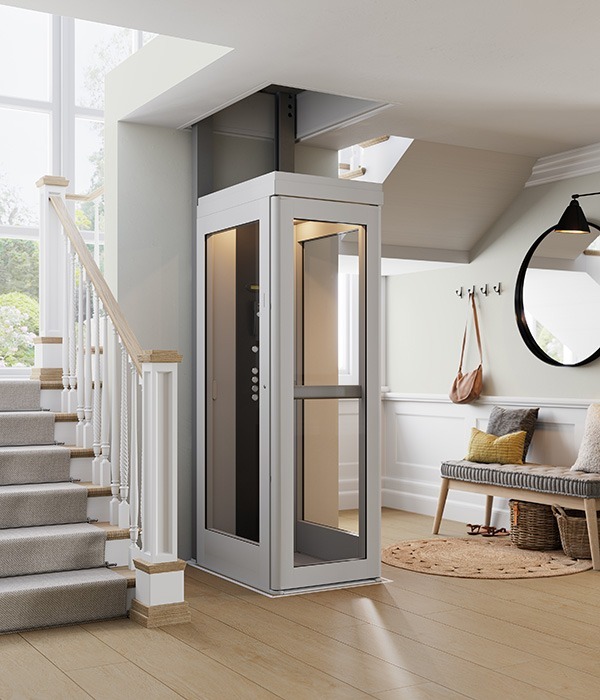
Home elevators are special lifts designed for houses. They help people move easily between different floors, similar to elevators in larger buildings but smaller and for personal use.
In this blog post, we will discuss how elevators work, the different types you can have in your home, and what makes them so helpful and interesting. Let’s learn about these handy machines!
Understanding Home Elevator Basics
Types of Home Elevators
Residential home elevators are like smaller versions of the ones you find in office buildings, but they’re made for houses. There are three main kinds. Hydraulic elevators are known for moving really smoothly, kind of like gliding up and down. They work using a special fluid and a pump.
Traction elevators use cables and a system of weights to move, which is like using a pulley. Lastly, there are pneumatic vacuum elevators. These are pretty cool because they use air pressure to go up and down, almost like a science fiction spaceship.
Key Components
Every home elevator has some important parts. The elevator car is the space you stand in when you ride. It’s like a small room that moves between floors. The machine room is where all the machinery that makes the elevator work is kept. It’s like the control center for the elevator.
Then there are the cables, which are really strong and hold up the elevator car. They’re what make the car go up and down. The shaft is the vertical tunnel the elevator car travels through. It’s a very important part of the whole setup, ensuring the elevator moves smoothly and safely.
The Mechanics Behind Home Elevators
Traction Elevators
Traction elevators operate by balancing the weight of the elevator car with a counterweight. This setup ensures the elevator moves up and down smoothly and efficiently, using cables for support. It’s a reliable system that’s common in many homes.
These elevators are energy-efficient because they use less power, making them a practical choice for residential use. Plus, they tend to be faster than other types, making them suitable for homes with multiple floors.
Hydraulic Elevators
Hydraulic elevators move by using a hydraulic ram and jack system, where hydraulic fluid is pumped to create motion. This results in a very smooth and comfortable ride, ideal for home use. They’re often installed in smaller buildings as they don’t require a lot of space for machinery overhead.
Their design makes them very sturdy and capable of carrying heavier loads compared to other types, which can be beneficial for moving larger items between floors.
Pneumatic Vacuum Elevators
Pneumatic vacuum elevators work using air pressure, creating a vacuum to lift the elevator car and then letting air in to lower it. This innovative system is not only efficient but also requires less space and fewer mechanical parts. These elevators are known for their futuristic design, often being transparent for a 360-degree view.
They are a great choice for adding a modern touch to a home, and their installation is typically quicker and less invasive than other types of elevators. Plus, their unique operation is a conversation starter, combining style with functionality.
Each type of home elevator offers its own set of advantages. Whether it’s the speed and efficiency of traction elevators, the smooth and steady ride of hydraulic ones, or the cutting-edge design of pneumatic vacuum elevators, homeowners have a variety of options to suit their needs and preferences. These elevators not only enhance mobility within a home but also contribute to its overall value and appeal.
Design and Installation Aspects of Home Elevators
Understanding Space Requirements
Planning for a home elevator starts with figuring out where it can fit. Regular elevators need a shaft, which is like a big vertical hallway, and a machine room for all the mechanical parts.
These take up quite a bit of room in your house, so you need to think about where they can go, especially if your house wasn’t built with an elevator in mind. You need to make sure there’s enough space for these without making big changes to your house. It’s like finding the right spot for a large piece of furniture, only this one moves between floors.
The Rise of Shaftless Elevators
Shaftless elevators are getting more popular because they don’t need as much room. They work without the big vertical hallway, so they’re great for smaller homes or adding an elevator without too much construction. They’re easier to put in, which saves time and hassle. Think of them like a simpler version of the big elevators, but for your home. They’re perfect if you want to avoid turning your home into a construction site.
Installation Process Overview
Installing an elevator in your home is a step-by-step process. For traditional ones, you build the shaft first, then put in the machinery and wiring. With shaftless elevators, you just prepare a smaller space. After everything is installed, the most important part is making sure it’s all safe and meets official safety standards.
This means double-checking that every part is in the right place and works correctly. It’s like building a complex toy – you have to follow the instructions carefully and make sure every piece is where it should be for it to work right. In the end, you get a safe and smooth-running elevator in your home.
Safety Features and Systems: Essential for Home Elevator Security
1. Reliable Emergency Systems
Modern home elevators prioritize safety above all. One key feature is the emergency brake system, which activates instantly in unusual situations to halt the elevator.
Automatic door locks are another critical component, ensuring that doors remain securely closed during transit. For added safety, many elevators also incorporate an emergency telephone or alarm system, providing a direct line for assistance in case of any unforeseen issues.
2. Structural Stability
The structural integrity of an elevator is paramount. Rail structures serve as the backbone of home elevators, providing the necessary stability and smooth operation. These rails are engineered to withstand the elevator’s operational stresses, ensuring a secure and steady ride every time.
3. Power Failure Protocols
A frequent concern with elevators is their operation during power outages. Modern safety elevators are designed with this in mind, featuring automatic lowering systems.
These systems are activated during power failures, gently bringing the elevator car to the nearest floor and allowing passengers to exit safely. This feature not only adds a layer of safety but also reassures users that they won’t be left stranded in the event of an electrical interruption.
Conclusion
In conclusion, home elevators are impressive machines that make moving around homes easier and add to their value. They work in different ways – through traction cables, hydraulic systems, or pneumatic vacuum technology, each offering unique benefits.
Not just a convenience, they’re also designed for safety with emergency systems and stable structures. If you’re thinking of getting one, it’s good to talk to experts to find the best fit for your home. With the right choice and installation, a home elevator can significantly enhance your living experience, blending practicality and luxury.



